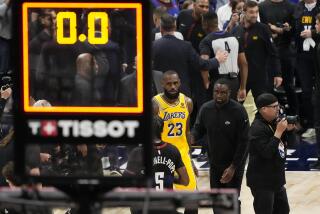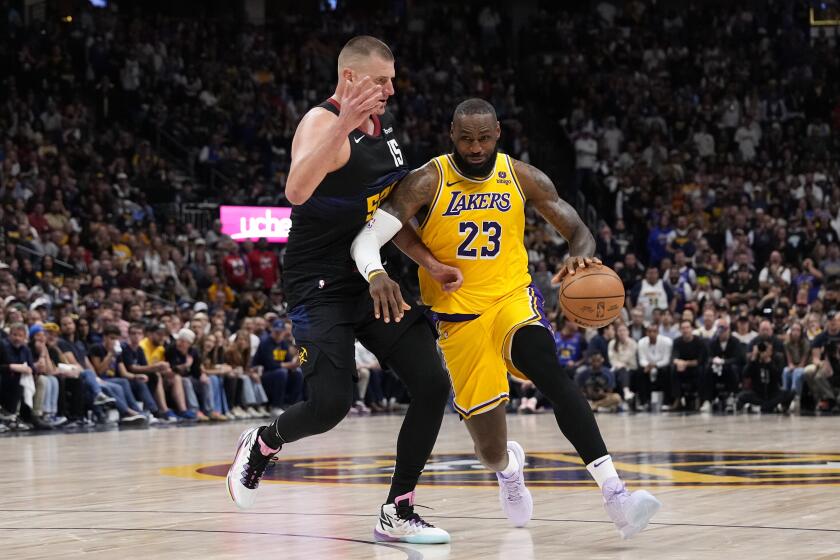Clemente Remains Special to Ex-Mates
The plane was old, with a history of problems, the kind of aircraft to be avoided. But this was a rescue mission, a hastily arranged trip carrying supplies to earthquake victims. The flight had already been delayed 16 hours. There was no time to look for a replacement plane.
So on Dec. 31, 1972, at the airport in San Juan, Puerto Rico, five men loaded 16,000 pounds of relief supplies onto the prop-driven DC-7 and prepared to fly to Nicaragua.
One of the men was Roberto Clemente.
This was New Year’s Eve, a night to party. In Pittsburgh, where the 38-year-old Clemente had played baseball for 18 brilliant seasons, two of his teammates were doing just that. Pitchers Steve Blass and Dave Giusti and their wives were at a party in Blass’ home.
Sometime after midnight, the phone rang with horrible news. There had been a crash. Reports were sketchy but it was believed to be the sad-sack relief plane that Clemente was on.
Together, the pitchers drove first to the home of general manager Joe L. Brown, then to teammate Willie Stargell’s house to await confirmation.
Twenty-five years later, Stargell remembers that terrible night and his terrific teammate.
“He was one of those special people,” he said. “He touched a lot of people’s lives. He was given the opportunity to do something and he did it as well as he could. That is his legacy.”
Clemente was a humanitarian, less concerned with the lighthearted life of a major league ballplayer than he was with other worldly issues.
“He had more awareness, more concern than a lot of us,” Blass said. “He had already been to Nicaragua once after the earthquake with supplies and had done a clinic there. He was concerned with how the supplies were being distributed, so he was going back. The New Year’s Eve flight was a second trip.”
Clemente, a native of Puerto Rico, was the heart and soul of those Pittsburgh Pirates, one of the greatest players of his era. And yet he always played under a cloud, often labeled as a complainer, a hypochondriac who was troubled by injuries, some real, some dismissed as imagined.
Stargell still is annoyed at that image.
“How are you going to get 3,000 hits if you’re a hypochondriac?” he asked. “We faced Koufax, Drysdale, Gibson, Marichal, Perry, a young Seaver, Ryan, Carlton, Jenkins. That’s the kind of baseball we had to play. To have the success he had against that kind of talent, it’s overwhelming.
“We got a chance to see a very special individual. As a teammate, we had a chance to marvel at talents a lot of people didn’t understand.”
Clemente nearly never made it to Pittsburgh.
The Brooklyn Dodgers signed him for $10,000 in 1954 and tried to hide him with their Montreal farm team, knowing that because he had gotten more than $4,000, he would have to be protected or be made eligible for the draft.
Clemente, who was right-handed, was allowed to hit only against right-handed pitchers.
“We figured he’d hit .120 and nobody would be interested,” said Buzzie Bavasi, then the Dodgers general manager. “He hit anyway. You can’t hide the great ones.”
In Pittsburgh, ex-Dodgers boss Branch Rickey knew all about the young slugger and Brooklyn brass knew that Rickey knew.
“When Mr. Rickey left for Pittsburgh, he wanted me to go along,” Bavasi said. “I told him I wanted to stay with the Dodgers and he said if there was ever anything he could do for me to let him know.”
Now, there was something.
Bavasi flew to Pittsburgh. “I went in to see Mr. Rickey and I told him he sort of owed me a favor. I said I was going to leave a young pitcher, John Rutherford, available for the draft and would appreciate it if the Pirates would take him instead of Clemente. Mr. Rickey agreed.”
Bavasi’s coup fell apart the day before the draft during National League meetings in New York when Rickey and Dodgers owner Walter O’Malley got into an argument over--what else?--money.
“They called me and said, ‘The deal’s off,’ ” Bavasi said. “And that’s how they got Clemente.”
Once in Pittsburgh, Clemente quickly established himself as one of the best players in baseball.
First, there was that bat.
He hit .311 in his second season, the first of 13 .300 seasons. Four times, he led the league in batting, including a high of .357 in 1967. Twice, he led the league in hits.
And there was that arm.
Clemente had a rifle in right field. Runners learned not to take chances with him. When they did, he often threw them out. He had 266 assists, 18th best in major league history. No outfielder since he played has had that many career assists.
The Pirates became defined by his enormous talent.
“He was a leader by example,” Blass said. “He didn’t engage in a lot of idle chatter. He chose his words carefully. He was concerned there was always a chance he’d be misinterpreted.
“He had a good sense of humor, but he was guarded. He knew who was around. If he was there with his teammates, the manager and coaches, he’d be looser. If others were in the room, he’d be careful.”
Clubhouses are fun places for players. Clemente, however, viewed them as his office where he would meticulously prepare for each game. He always seemed to have a problem getting loose and went through a complex routine of neck-stretching and back-arching before each at-bat, trying to find a comfort zone.
“He had a pregame ritual of having his neck worked on in the trainer’s room,” Blass said. “I’d sneak under the trainer’s table and I’d imitate Peter Graves in ‘Mission Impossible.’ You know . . . ‘Good morning, Mr. Clemente, I am your neck. Your assignment today . . . ‘
“He’d hear me and he’d snicker.”
*
Despite the four batting titles and a career .317 average, Clemente believed he was overlooked, lost in the media excitement over stars like Hank Aaron and Willie Mays. “He understood the market status in Pittsburgh,” Blass said. “He wasn’t in New York, Chicago or L.A. It drove him and it motivated him.”
Stargell thought that small-market argument was nothing more than an excuse to ignore Clemente.
“If you look for excuses, you can find them anywhere,” he said. “A diamond is a diamond. I don’t care where it’s at.”
And Clemente was a gem on every diamond.
*
In 1971, with the Pirates in the World Series against Baltimore, Clemente finally had the chance he needed on the national stage. “Now they will see how I play,” he said.
“That Series was his personal deal,” Blass said. “It was his showcase, a chance for others to see what we in Pittsburgh had seen for a lot of years.”
Clemente played those seven games like a man on a mission. He batted .414 with 12 hits in 29 at-bats including two home runs, two doubles and a triple. He ran the bases with abandon and played flawlessly in right field, uncorking laser throws to hold runners. He was the unquestioned MVP.
Blass won two games in that Series, including a four-hit shutout in Game 7. “I’m going to win the (MVP) car if not for him,” he said.
On the plane back to Pittsburgh after Game 7, Clemente sought out Blass and the two embraced. It was an emotional moment that stays with Blass to this day.
*
Clemente ended the 1972 season with an exclamation point--his 3,000th hit, a double against Jon Matlack of the New York Mets.
As he stood at second base, hands on hips, one foot on the base, the other on the ground, he seemed like a heroic figure, a proud man who had accomplished all that he had to accomplish.
“I still have that mental image of him standing there,” Blass said.
Three months later, the slugger would be dead.
Stargell will never forget his friend.
“He helped us in a lot of ways to be the players we were,” the Hall of Famer said. “A lot of his teaching is being taught today, 25 years later. When you have an impact person, that impact never dies.”
More to Read
Get our high school sports newsletter
Prep Rally is devoted to the SoCal high school sports experience, bringing you scores, stories and a behind-the-scenes look at what makes prep sports so popular.
You may occasionally receive promotional content from the Los Angeles Times.






